

![]()
![]()
This Page:
Flora M. Reid
Ellis Rowan
Alice Squire
Maria Spartali Stillman
Marianne Stokes
Annie Louisa Swynnerton
Helen Thornycroft
Mary Lemon Waller
Henrietta Ward
Kate Mary Whitley
Eleanor Stuart Wood
Annie Mary Youngman
![]()
![]()

Self Portrait--
representative work
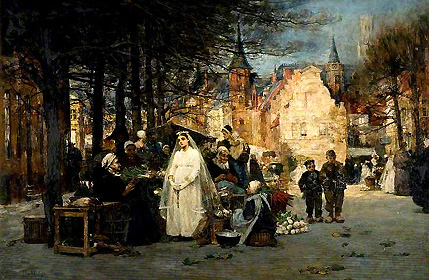
First communion--representative work.
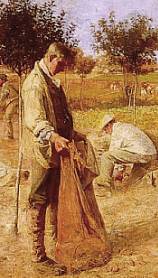
Potato Harvesters (1883)
--representative work.

Figures in the Marketplace--
this may or may not
be In the Marketplace
exhibited in Fine Arts Palace, 1893 Exposition.

Hush--exhibited in
Fine Arts Palace, 1893 Exposition.
Scottish artist Flora MacDonald Reid was trained by her artist-brother John Robertson Reid and at the Edinburgh School of Art. She lived for many years in France, Norway, and Belgium, but continued exhibiting at the British Royal Academy.
![]()

The Royal Botanical Gardens, Melbourne (1883)--representative work.

Birds--
representative work.

Bird of Paradise--
representative work.
Panel of Lilies and Panel - Acanthus, plus collection of
99 pictures of flora of Australasia (images unavailable)
--exhibited in the Fine Arts Palace, 1893 Exposition.
Ellis Rowan is one of Australia's most important wildflower painters, producing more than 3000 paintings of native flora, birds, and insects with scientific accuracy. Untrained but encouraged by her husband, she became a highly successful artist, but was disparaged by some critics because she was so prolific. However, stylishly dressed, she continued to brave crocodiles and perilous river journeys to remote parts of the country in search of her subjects.
![]()

Mother and Child by a River 1883--representative work.
Quiet Stream; Springtime; and An Autumn Afternoon
(images unavailable)--exhibited in the Fine
Arts Palace, 1893 Exposition.
Alice Squire was a British artist. No other information about her appears online.
![]()

Self-portrait in Medieval Dress
1874--
representative work.

Portrait of Michael (Mico) Stillman
1884--representative work.
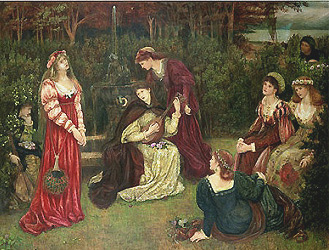
Fiammetta Singing 1883--representative work.

Woman Reading--
representative work.
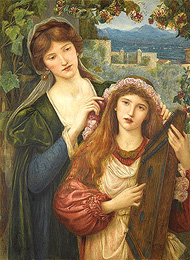
The Childhood of St. Cecily
--representative work.
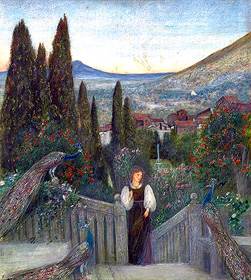
Lady with Peacocks in Garden:
Italianate Landscape beyond
1896--representative work

Feeding Doves, Kelmscott Manor
1883--representative work.
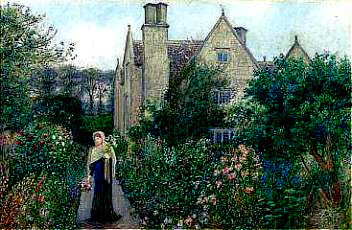
Long Walk, Kelmscott Manor
1883--representative work.

How the Virgin Mary Came to Brother Conrad of Offida and Laid
Her Son in his Arms 1892--Since "currado" and "conrad" are
both the same name, this most likely is Fra Currado d’ Offidi
(also known as The Legend of Fra Currado D'offidi) which
was exhibited in the Fine Arts Palace, 1893 Exposition.
Marie Spartali Stillman, the daughter of a wealthy merchant and former Greek consul in London, grew up in a cosmopolitan society consisting of naturalized Anglo-Greeks, artists, musicians, and political exiles from Crete and Italy. She studied art under Ford Madox Brown and modeled for Pre-Raphaelites like Rossetti, Burne-Jones, and Julia Margaret Cameron. The Pre-Raphaelite influence can be seen in many of her paintings. After marrying an American journalist, she alternated between living in England and living abroad in Florence and Rome for many years, but she continued to exhibit in England.
![]()
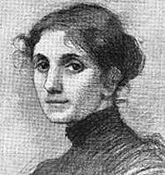
Self Portrait--representative work.

The Glass Cleaner, at Night 1890--
representative work.

Der Milchtopf 1891--
representative work.

Polishing Pans 1891
--representative work.
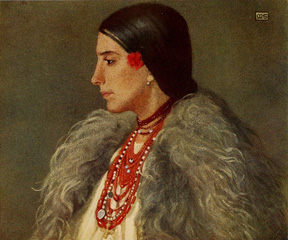
Woman of Desze c.1909--
representative work.

Childhood's Treasures 1886--representative work.
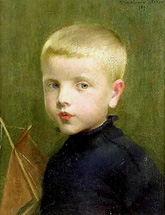
Portrait of a Boy with a
Model Sailing Boat 1893--
exhibited in Fine Arts
Palace, 1893 Exposition.
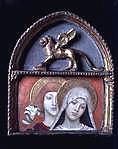
Hail, Mary 1891--exhibited in
Fine Arts Palace, 1893 Exposition.

Go; Thou Must Play Alone, My Boy
[sub-title: Thy sister is in heaven.] 1891--
exhibited in the Fine Arts Palace, 1893 Exposition.
Born in Austria, Marianne Stokes studied art in Munich with W. von Lindenschmit and in Paris with M. Dagnan Bouveret and M. Courtois. After she married British landscape artist Adrian Stokes, she lived in the artist community in St. Ives, Cornwall and other places in England. Her earlier work shows the influence of Lepage and Millet ("plein air" social realism); by the turn-of-the-century, religious and historical subjects, somewhat stylized, predominated. She won a medal at the 1893 Exposition. The title of the above image comes from Mrs. Hemans' pathetic poem of mourning called "The Boy's First Grief": "The rose's brief, bright light of joy, / Such unto him was given; / Go, thou must play alone, my boy! / Thy brother is in heaven"--or his sister, in the picture.
Group in a Rumanian Religious Procession, Desze
Rumanian Children bringing Water to be Blessed in the Greek Church, Desze
Paintings from under High Tatra Mountains--scroll down the page for 4 portraits by Stokes
![]()
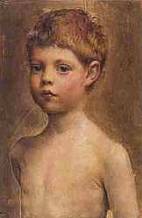
Portrait of a Boy--
representative work.

Dreamer 1891--
representative work.

Portrait of Young
Italian Man--
representative work.
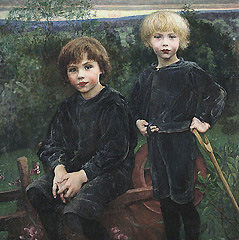
Geoffrey and Christopher
Herringham 1889--
representative work.

Mater Triumphalis 1892--
exhibited in the Fine Arts
Palace, 1893 Exposition.
Portrait of Miss Jane Atkinson
(image unavailable)--exhibited in
the Fine Arts Palace, 1893 Exposition.
Born near Manchester, England, Annie Louise Swynnerton began painting to assist her solicitor father in supporting his seven daughters. Her later formal training was at Manchester School of Art and at the Académie Julian in Paris, followed by many years living in Rome with her sculptor husband. Known for her allegorical paintings, she also exhibited many portraits at the British Royal Academy and, in 1910, was the first woman to be elected an Associate of that prestigious organization. Swynnerton was asked to create a mural --a triptych on Woman's Work--for the vestibule in the Women's Building. The mural showing three different phases of nursing has been presumably lost, but featured a central panel of Florence Nightingale caring for wounded soldiers at the hospital at Scutari during the Crimean War, flanked on either side by smaller pictures of a mother caring for a child and a granddaughter caring for her invalid grandmother.
![]()
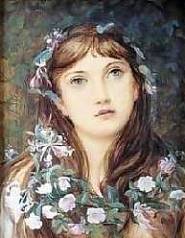
Honeysuckle--
representative work.

Narcissus Herringham--
representative work.

Still Life of Tulips in a Glass Vase
(1891)--representative work.
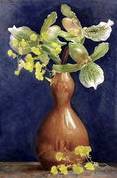
Orchids in a
Copper Vase
1881--may or may
not be one of the
two "orchid"
paintings exhibited
in the Fine Arts
Palace, 1893
Exposition.

Orchid
in a Glass
Dolphin Vase--
may or may not
be one of the
two "orchid"
paintings exhibited
in
the Fine Arts Palace,
1893 Exhibition.
Shirley Poppies and Azalea, with Bronze
Figure of 'The Mower' (images unavailable)--
exhibited in Fine Arts Palace, 1893 Exposition.
Helen Thornycroft was born into a family of sculptors (grandfather, mother, father, and brother 'Hamo'), but Helen like her two sisters (Alyce and Theresa) turned to painting, studying along with her siblings in the Royal Academy schools in the 1860s when they first began admitting women. Helen is primarily remembered for her flower paintings, although she also painted in other genres.
![]()

Self Portrait--(sketch of a painting)
--representative work.

Portrait of a Boy
--representative work.
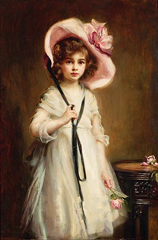
Portrait of a Girl
--representative work.

Reverend William Fowler
1888--representative work.
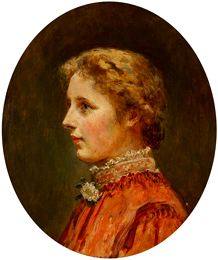
Portrait of an unknown
lady in profile 1881
--representative work.

Portrait of Richard
Waller as a Boy
--representative work.
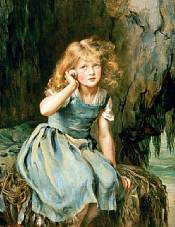
Listening to the Sea --
representative work.

The Card Dealer--exhibited in
Fine Arts Palace, 1893 Exposition.
Mary L. Waller began her art studies at the Art School in Gloucester while living at her father's vicarage in Gloucester and later at the Royal Academy Schools in London. Mary often exhibited her portraits in the London galleries. She married genre painter Samuel Edmund Waller who also exhibited at the 1893 Exposition. No other information is available online.
![]()
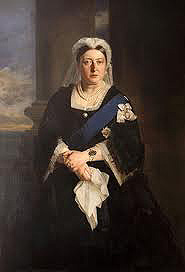
Queen Victoria--representative work.
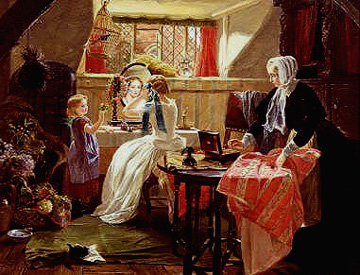
May Queen--representative work.
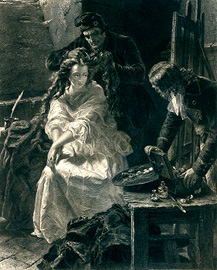
Last
Toilet of Charlotte Corday
1861--representative work.

Listening to the Sea --
representative work.

Mrs. Fry
Visiting Newgate, 1818-- 1876
version exhibited in Fine Arts
Palace, 1893 Exposition.
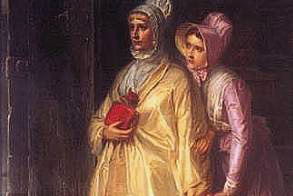
Mrs. Fry Visiting
Newgate, 1818--
detail from 1895 version
of same painting.
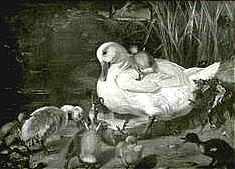
The Ugly Duckling--exhibited in
Fine Arts Palace, 1893 Exposition.
A successful historical and genre painter, Henrietta Ward was born in London into a family of painters (grandfather, father, and mother). She studied art at the Bloomsbury Art School and at Sak's Academy and, at age 16, married artist Edward M. Ward (she sometimes signed her paintings as Mrs. E. M. Ward). The Wards were favorites of Queen Victoria who gave them several commissions. Her well-known painting of Mrs. Fry (1876) shows the renowned Quaker reformer of women's prisons, accompanied by her young friend Mary Sanderson, entering the infamous Newgate prison for the first time. (The 1895 version omits the jailer and other figures.) In 1857, Ward supported the campaign to get the Royal Academy School to admit female students (accomplished in 1861). Her autobiography Memories of Ninety Years was published in 1924. Three of her eight children also became artists.
![]()
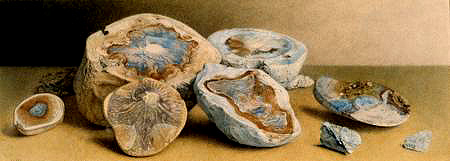
Fossils - Sponges--representative work.
Ammonite and Minerals (image unavailable)--exhibited
in the Fine Arts Palace, 1893 Exposition.
Kate Mary Whitley was a British artist. No more information is available online.
![]()
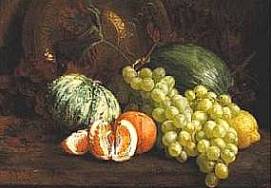
Still Life of Fruit on a Table (1893)--representative work.

End of the Hop Harvest, Kent--exhibited in the
Rotunda, Woman's Building, 1893 Exhibition.
Autumn (image unavailable)--exhibited
in Fine Arts Palace, 1893 Exposition.
Eleanor Stuart Wood grew up in Manchester, England, but as an adult, lived in London where she exhibited her still lifes and portraits. No other information is available online.
![]()

Hour of Prayer--
representative work.

Hellobores--
representative work
Pelargoniums and Rhododendrons
(images unavailable)
--exhibited in Fine Arts Palace, 1893 Exposition.
Annie Mary Youngman was the daughter of British watercolor painter John Mallows Youngman. She studied landscape and flower painting at South Kensington School of Art and the Royal Academy School. Evidently she exhibited internationally and won several awards.
![]()
![]()
Go to Canadian Women Painters, p. 1
Return to Women Painters Index
Return to Site Index
![]()
![]()
Text written by K. L. Nichols
Painting, top of page: Marie Konstantinovna
Bashkirtseff,
In the Studio (1881).
Return to Nichols Home Page
Suggestions/Comments: knichols11@cox.net
Posted: 6-25-02; Updated: 6-1-19